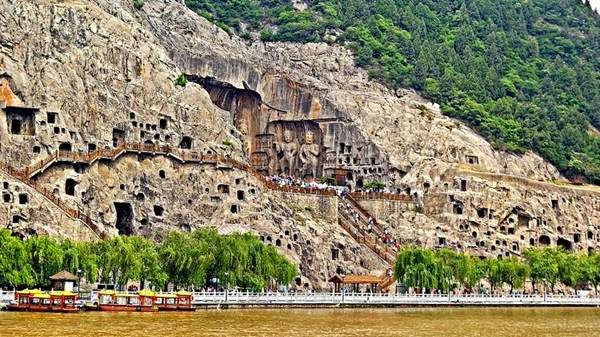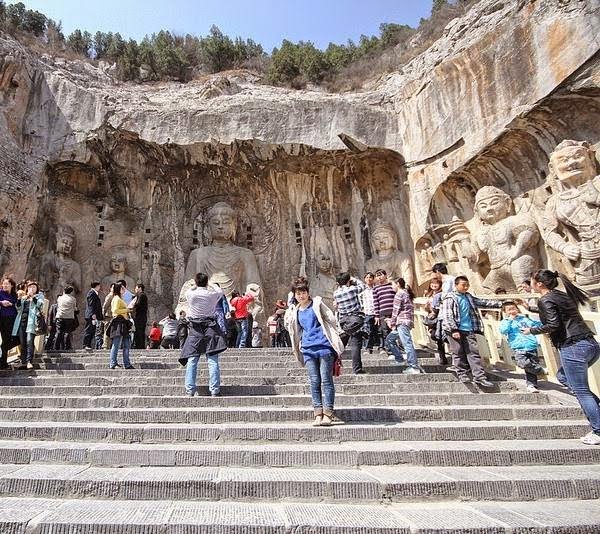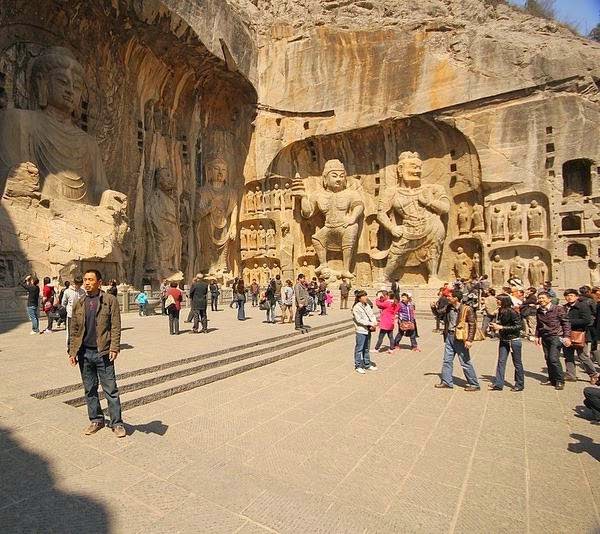Longmen Grottoes of China
كهوف لونغمن في الصين
Buddhist cave temples took over 400 years to carve into the rock.
كهوف معابد بوذية استغرق حفرها في الصخر 400 سنة.
Longmen Grottoes are a series of Buddhist cave temples carved into the rock on the banks of the Yi River, 12 km south of the city of Luoyang, in Henan province, in China. The site includes some 1,350 caves and 40 pagodas, full of statues of all shapes and sizes, ranging from 1 inch to the largest Buddha statue of 17 meters tall. There are as many as 100,000 statues carved out of the hard limestone cliffs. Stretching for 1 km along both banks of the river. The caves represent one of the finest examples of Chinese Buddhist art. Construction of the Longmen Grottoes began in 493 continued for over 400 years. كهوف لونغمن هي سلسلة من كهوف المعابد البوذية منحوتة في الصخر على ضفاف نهر يي على بعد 12 كم جنوب مدينة لويانغ في مقاطعة خنان في الصين. ويضم الموقع حوالي 1350 كهفاً و 40 معبداً، مليئة بالتماثيل من جميع الأشكال والأحجام، بدءا من تماثيل بطول بوصة واحدة لأكبر تمثال لبوذا بارتفاع 17 مترا. وهناك ما لا يقل عن 100 ألف تمثال منحوت في الحجر الجيري الصلد للمنحدرات الصعبة. وتمتد الكهوف مسافة كيلومتر على طول ضفتي النهر. وتمثل الكهوف واحدة من أفضل الأمثلة على الفن البوذي الصيني الرفيع. بدأ بناء كهوف لونغمن في عام 493م واستمر لأكثر من 400 سنة.
The caves have suffered from significant vandalism and looting over the years, beginning with the anti-Buddhist movement of the 9th century. Destruction continued at the hands of souvenir-hunting Westerners in the 19th and 20th centuries, which resulted in many statues ending up abroad in such institutions as the Metropolitan Museum of Art in New York, the Atkinson Museum in Kansas City and the Tokyo National Museum. During the Cultural Revolution, the site was attacked by the Red Guards who destroyed and decapitated many of the statues.
Today, the Longmen Grottoes are a protected site. In 2000, it was inscribed upon theUNESCO World Heritage List.وقد عانت الكهوف على مر السنين من تخريب ونهب كبيرين، بدءا من حركة مناهضة البوذية في القرن التاسع. واستمر النهب على أيدي صيادي الآثار الغربيين في القرنين الـ 19 والـ20، والذي أسفر عن نقل العديد من التماثيل إلى الخارج وانتهاؤها في مؤسسات مثل متحف متروبوليتان للفنون في نيويورك ومتحف أتكينسون في مدينة كانساس سيتي ومتحف طوكيو الوطني. وخلال الثورة الثقافية في الصين هوجم الموقع من قبل الحرس الأحمر الذي دمر وقطع رؤوس العديد من التماثيل.
أما اليوم فكهوف لونغمن أصبحت أحد المواقع المحمية. ففي عام 2000 وضعت ضمن قائمة التراث العالمي لليونسكو.
منقووول
















 رد مع اقتباس
رد مع اقتباس

